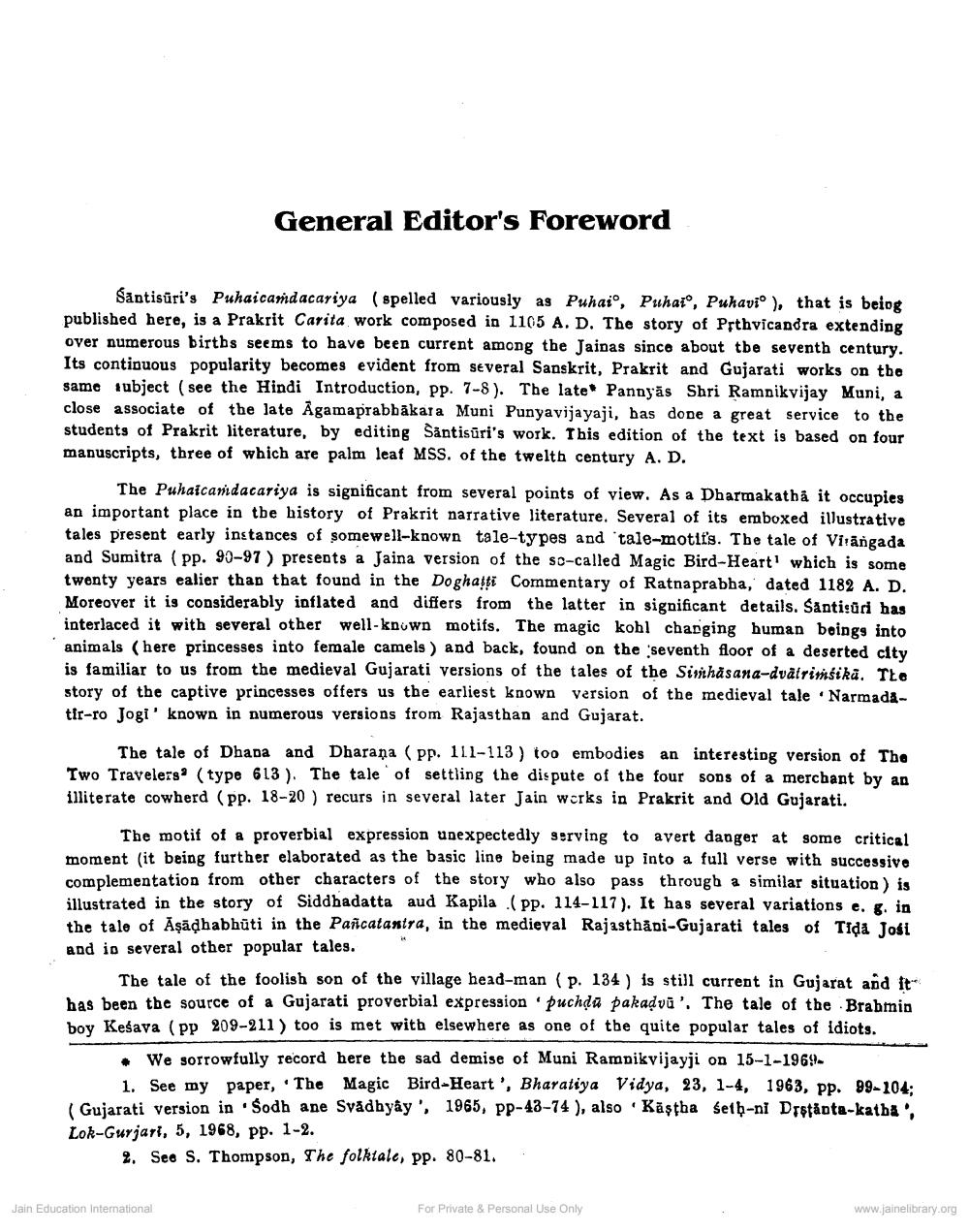Book Title: Puhaichandchariyam Author(s): Shantisuri, Ramnikvijay Gani Publisher: Prakrit Text Society Ahmedabad View full book textPage 8
________________ General Editor's Foreword Santisüri's Puhaicamdacariya (spelled variously as Puhaio, Puhaio, Puhavio ), that is being published here, is a Prakrit Carita work composed in 1105 A. D. The story of Pithvicandra extending over numerous births seems to have been current among the Jainas since about tbe seventh century. Its continuous popularity becomes evident from several Sanskrit, Prakrit and Gujarati works on the same subject ( see the Hindi Introduction, pp. 7-8). The late Pannyas Shri Ramnikvijay Muni, a close associate of the late Agamaprabhākara Muni Punyavijayaji, has done a great service to the students of Prakrit literature, by editing Säntisūri's work. This edition of the text is based on four manuscripts, three of which are palm leaf MSS. of the twelth century A. D. The Puhaicandacariya is significant from several points of view. As a Dharmakathả it occupies an important place in the history of Prakrit narrative literature. Several of its emboxed illustrative tales present early instances of somewell-known tale-types and 'tale-motits. The tale of Virängada and Sumitra (pp. 90-97 ) presents a Jaina version of the so-called Magic Bird-Heart' which is some twenty years ealier than that found in the Dogharti Commentary of Ratnaprabha, dated 1182 A. D. Moreover it is considerably inflated and differs from the latter in significant details. Säntigüri has interlaced it with several other well-known motifs. The magic kohl changing human beings into animals (here princesses into female camels) and back, found on the seventh floor of a deserted city is familiar to us from the medieval Gujarati versions of the tales of the Sinhasana-dväirimsika. TŁO story of the captive princesses offers us the earliest known version of the medieval tale Narmadatir-ro Jogi' known in numerous versions from Rajasthan and Gujarat. The tale of Dhada and Dharana (pp. 111-113 ) too embodies an interesting version of The Two Travelers (type 613). The tale of settling the dispute of the four sons of a merchant by an illiterate cowherd (pp. 18-20 ) recurs in several later Jain works in Prakrit and Old Gujarati. The motif of a proverbial expression unexpectedly serving to avert danger at some critical moment (it being further elaborated as the basic line being made up into a full verse with successive complementation from other characters of the story who also pass through a similar situation is illustrated in the story of Siddhadatta aud Kapila (pp. 114-117). It has several variations e. k. in the tale of Āsādhabhūti in the Pascatantra, in the medieval Rajasthani-Gujarati tales of Tida Josi and in several other popular tales. " The tale of the foolish son of the village head-man (p. 134 ) is still current in Gujarat and it has been the source of a Gujarati proverbial expression puchda pakadvu'. The tale of the Brabmin boy Kesava (pp 209-211 ) too is met with elsewhere as one of the quite popular tales of idiots. We sorrowfully record here the sad demise of Muni Ramnikvijayji on 15-1-1969 1. See my paper, The Magic Bird-Heart', Bharatiya Vidya, 23, 1-4, 1963, pp. 99-204: ( Gujarati version in Sodh ane Svadhyây', 1965, PP-43-74 ), also Kāştha seth-ni Distanta-katba Lok-Gurjari, 5, 1968, pp. 1-2. 2. Seo S. Thompson, The folktale, pp. 80-81. . Jain Education International For Private & Personal Use Only www.jainelibrary.orgPage Navigation
1 ... 6 7 8 9 10 11 12 13 14 15 16 17 18 19 20 21 22 23 24 25 26 27 28 29 30 31 32 33 34 35 36 37 38 39 40 41 42 43 44 45 46 47 48 49 50 51 52 53 54 55 56 57 58 59 60 61 62 63 64 65 66 67 68 69 70 71 72 73 74 75 76 77 78 79 80 81 82 ... 323
